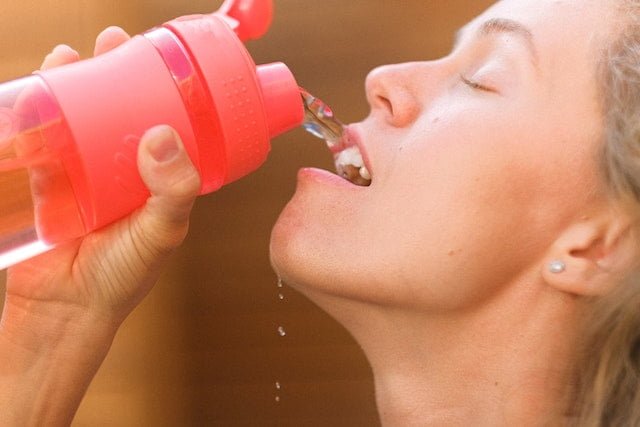Hydration: More Than Just Drinking Water

As we approach the heights of summer heat, you may find yourself wearing more water than you take in.
Sometimes it may seem alarming how much our bodies can excrete – but it makes sense when taking into account that our bodies are made of up to 75% water (with generally higher amounts in men than in women). Each day, we naturally lose body water primarily through our lungs and skin. Other conditions such as high altitude, high temperatures, diarrhea, and physical exertion can all greatly increase water loss.
How Many Drops to Drink?
A general guideline for daily water consumption is to drink one ounce of water per pound of body weight. This makes it possible to tailor more to body composition needs.
However, in this time of high activity and high temperatures, experts have different water intake recommendations depending on activity level and one’s state in life.
- When exercising, it’s best to increase water intake by 1.5 ml per calorie burned in order to make up for excess sweating and solute load.
- When pregnant, consider increasing water intake to support the needs of the developing baby by about 30 ml/day.
- When breastfeeding, consider increasing water intake by 750 ml/day, since breast milk is made of 87% water.
Symptoms of Dehydration
So how do you know you’re dehydrated? Thirst certainly is an indicator, but once it progresses, many people no longer feel thirst and experience other more serious symptoms such as:
- Dizziness
- Fatigue
- Fainting
- Muscle Cramps
- Vomiting
If you’re like me and living in an especially dry climate, you may already be accustomed to drinking lots of water to compensate. But what you may not know is that water is not the only important factor in the body being truly hydrated.
The Unsung Heroes: Electrolytes
In order for water to be able to travel among and within cells, our bodies need to consume a proper balance of electrolytes. These electrically-charged particles deliver messages and water to their proper places within the body similar to how electricity provides light, heat, and many other necessities for homes.
Have you noticed that when you’re thirsty you also tend to crave salty foods – and then when you eat salty foods, you become thirsty? There’s a reason for that! Salt is one of several minerals considered to be electrolytes. Others include potassium, chloride, magnesium, and calcium. In the proper amounts, these minerals work synergistically to move water within the body to and within cells. They also balance overall fluid content throughout the body.
How Many Minerals to Hydrate?
So, if minerals need to be properly balanced and present, how much is already present in our water, and how much should we consider adding?
To give proper context, here are the suggested total daily consumption for each mineral:
- Sodium: adequate intake values are 1500 mg per day for ages 19-50, 1300 mg per day for ages 51-70, and 1200 mg per day for ages 71 and above.
- Potassium: adequate intake values are 4700 mg per day for adults. When breastfeeding, it jumps to 5700 mg per day.
- Chloride: adequate intake values are 2300 mg per day for ages 19-50, 2000 mg per day for ages 51-70, and 1800 mg per day for ages 71 and above.
- Magnesium: recommended daily allowance values are Men 400 mg per day for men and 310 mg per day for women.
- Calcium: recommended daily allowance values are 700 – 1000 mg per day for children, 1300 mg for ages 9-18, 1000 mg per day for ages 19-50, and 1200 mg per day for ages 51 and above.
If we do not consume the proper amount of minerals daily, our bodies will struggle to maintain proper fluid balance. When external conditions are temperate and there’s relatively low movement, most healthy adults eating a balanced, whole-foods diet should be able to maintain sodium levels without needing to add them to water. Tap water does contain electrolytes – though it varies, it typically contains calcium, sodium, and magnesium but little potassium.
However, in certain states of life, seasons, and activity level, we can lose more minerals – especially sodium – with sweat. In fact, we lose 1 gram of sodium for every liter of sweat.
When exercising for longer than 75 minutes, pregnant, or breastfeeding, consider adding electrolytes to your water to replace lost minerals.
Sports Drinks: Friends or Foes?
When adding electrolytes, many athletes immediately turn to sports drinks such as Gatorade – which has 36 grams of sugar in a single serving. Though certain physical exertion does require calorie replacement through carbs, having high levels of sugar brings more negative health side effects than positive ones.
Thankfully, there are other options to increase electrolytes without overdoing the sugar load:
- Adding a shake of Himalayan pink salt, Celtic salt, or sea salt to your water
- Purchasing all-natural electrolyte powder with no added sugar
Eat Your Minerals
Since our bodies are made to utilize nutrients from food sources, we not only drink electrolytes, but we also eat them in many types of fruits and vegetables. Especially in the summer months when we are in need of more minerals, it’s important to consider prioritizing these particular food sources.
- Sodium-rich foods include: unrefined sea salt, most meats, seaweed, celery, beets, cantaloupe, seafood, and eggs
- Potassium-rich foods include: vegetables, fruits, meat, legumes, and dairy
- Chloride-rich foods include: unrefined salt, soy sauce, milk, meats, eggs, vegetables, olives, dulse, and kelp
- Magnesium-rich foods include: whole grains, nuts, legumes, dark green vegetables, seaweed, seafood, cocoa, dark chocolate, and hard/mineral water
- Calcium-rich foods include: dairy foods, canned fish with bones (most bioavailable sources), leafy greens, legumes, nuts, seeds, and grains
- Note: consider soaking nuts, seeds, and grains to neutralize phytates which bind minerals in the GI tract and prevent the absorption of nutrients
Eat Your Water, Too
Did you know that the very food you eat can also hydrate you? Here are some foods that you might find to be especially refreshing in the summer heat:
- Watermelon
- Contains 91.45% water and trace amounts of Vitamin C, A, B, potassium, zinc, and copper
- Spinach
- Contains 91.4% water and calcium, iron, potassium, Vitamin A, folate, and fiber
- Strawberries
- Contains 90.95% water, Vitamin C and antioxidants
- Cucumber
- Contains 96.73% water and trace amounts of magnesium, calcium, and phosphorus
- Celery
- Contains 95.43% water, fiber, and trace amounts of Vitamin K, A, potassium, and folate
- Tomatoes
- Contains 94.52% water, fiber, and trace amounts of Vitamin K, A, potassium, and folate
- Zucchini
- Contains 92.73% water and trace amounts of Vitamin C, A, K, potassium, magnesium, manganese, and folate
Is drinking water a chore for you or one of your loved ones? Consider adding a combination of the above fruits and vegetables to your next glass of water to not only enhance the flavor but also the nutrients. Some of the nutrients happen to include those trusty electrolytes too. Here are some flavor combinations to consider to upgrade your water experience:
- Watermelon Mint
- Strawberry Cucumber
- Pineapple Mint Ginger
- Lemon
- Raspberry Orange
- Orange Fennel
As temperatures continue to climb this summer, consider bringing not only water but also electrolytes into your diet. Your body will thank you for the extra electric boost of vitality!
About the author: Lisa (Driscoll) Lopes is a certified Nutrition Therapist Master through NTI’s Nutrition Therapist Master Program. Having studied journalism and vocal performance in undergrad, she enjoys using her voice to share the benefits of living a holistic, integrated lifestyle in writing. You can find more of her writing in the Baltimore Sun, Classical Singer Magazine, Capital News Service, and FOCUS blog.
Images:
- Image by Anna Shvets from Pexels
- Image by Shameel mukkath from Pexels
Source link
#Hydration #Drinking #Water



